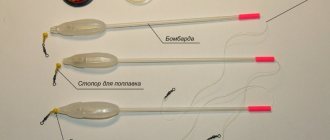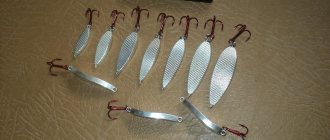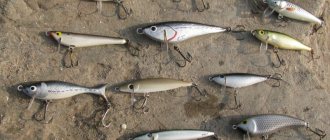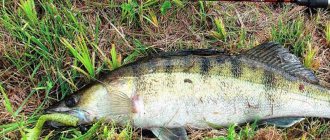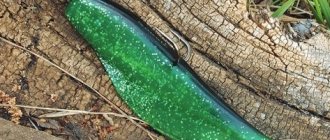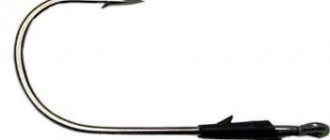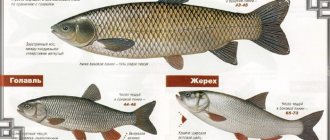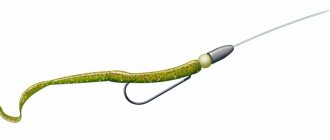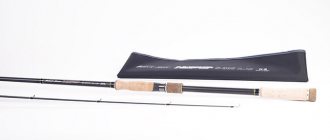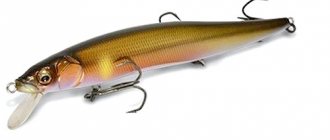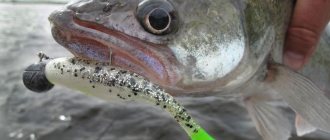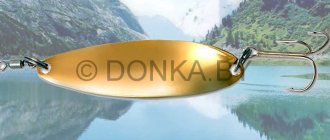The castmaster for asp is one of those few baits that has entered the spinning angler’s arsenal as a purely specific tool for catching this very careful, cunning and in vain fish that is not very popular with a larger circle of anglers. This predator, although its population is quite widespread in our reservoirs, due to the peculiarities of fishing, does not often become a trophy for spinning anglers. Many fishermen mistakenly believe that catching this powerful predator is a technically difficult and unsolvable task and do not even think that catching a large asp with a castmaster with a fly can bring quick and significant results even to a novice fisherman.
To completely dispel doubts about the difficulties of fishing, we recommend reading this article, which will reveal the secrets of catching this lively fish in the nuances of selecting equipment, places and times of hunting and the use of cut-type spinners, which allow technically simple but effective fishing.
Where to fish
The predator prefers to live in large rivers with moderate currents without regard to depth levels, since, depending on the season, it hunts in the water horizons where its favorite prey in the form of bleak descends. In the spring and summer months, small groups of predators, consisting of three to five fish feeding at relatively short distances from each other, stay in the upper layers of the water, where bleak and other small fish constantly rotate to collect insect carrion. In autumn, fishing is carried out in the middle and deep water layers, where our lively hero goes down to collect small things in preparation for winter.
Important! This fish does not like quiet and overgrown areas of water areas and stays in wide open water areas, adhering to the boundaries of mixing fast and slow water flows.
In summer, the fish can be identified by its characteristic fight on the water, when it crushes a school of small fish with its tail, subsequently collecting the stunned prey. In autumn and closer to winter, they look for trophies near winter roads, deep river holes where inactive peaceful fish stand.
Using fluorocarbon leaders
When preparing gear for catching asp with a castmaster, it is important to take care of a good leash. It is advisable to give preference to fluorocarbon models, since this material is invisible to predators and can withstand strong jerks from resisting fish.
However, the market offers a lot of cheap analogues of fluorocarbon, where it is used only as a shell. This option does not justify itself, because it quickly loses its properties and becomes damaged. The original models are not capable of letting water through or losing quality when exposed to the sun. They are quite expensive, but last much longer than fakes.
The advantages of fluorocarbon leashes include:
- Almost completely invisible in the water, even if it is transparent, and the fish is extremely cautious.
- Lack of stretchability and “memory effect”. The leash never stretches or loses its original shape.
- Quick dive to depth.
- No vulnerability to temperature fluctuations.
- No water absorption.
Depending on the size of the expected production, you need to choose the following leash diameters:
- 0.14 mm - can withstand loads of more than 1.36 kg.
- 0.16 mm – can be used for catching fish weighing up to 1.83 kg.
- 0.18 mm – intended for catching asps weighing up to 2.17 kg.
- 0.2 mm – can withstand loads of up to 4 kg.
If there is a chance to catch trophy prey weighing more than 6 kg, it is better to use a fluorocarbon leader with a diameter of 0.31 mm.
How to choose a castmaster for an asp
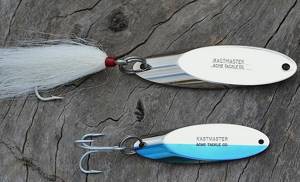
Catching lures of this type are selected based on hunting conditions, which include the levels of water horizons at which fishing will be carried out, the strength of the current, the intensity of daylight and the activity of the fish being caught. The levels of wiring and current strength are compensated by the selection of spinners of various weights and sizes. Surface fishing involves the use of short spinners weighing 3–10 grams; deeper depths are fished with tools 10 cm long and weighing up to 30 grams.
Important! In sunny weather, colors with a tint of gold and copper shine are suitable. In cloudy weather, a pure silver color is considered the most suitable option.
Various kinds of holographic stickers, additional flies and silicones, red threads on the tees contribute to the success of the selection of spinners by an inactive predator.
Castmaster wiring
Returning to the issue of wiring the castmaster, it is worth saying that uniform fast winding is only one way, the simplest. Some spinners consider this method of retrieving too primitive, but practice shows that it is also very effective.
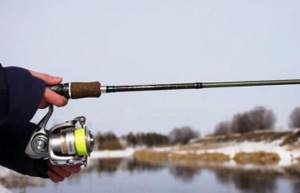
But step-by-step wiring on a pause is considered more exciting and often more effective. In this case, the castmaster planning time depends on the depth (layer of water) at which the asp is located.
Spinning equipment
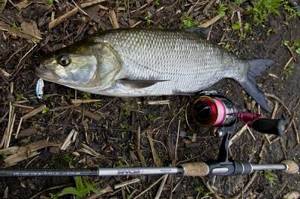
To ensure fishing, choose a medium plug spinning rod with a semi-fast action, in length from 2.1 to 2.7 meters. Due to the range of the bait, a longer tool is not required. The level of test parameters of 7–30 grams closes the implementation of postings at different depth marks. Inertia-free reels with a high gear ratio and a finely adjustable clutch with a spool with a capacity of 100 meters of 0.15-0.18 mm braid will harmoniously fit into the equipment package. The bait is tied directly to the cord, without leashes and a swivel, purely into the winding ring of the bait.
Important! The loads on the rod when retrieving a caught fighter, and the first blow to the bait is especially impressive in terms of power, is prohibitive. Therefore, it is recommended to purchase graphite or composite tackle, the material of which is highly durable under overload.
Leashes with baits
The use of additional leashes with twisters or wabs, which are mounted above the castmaster, significantly activates the bite. The fisherman should take into account that the hooks on additional leashes must be large and strong in order to withstand the bite of a river corsair. Often the line breaks on the leash when a fish hits or while fishing.
The asp always offers fierce resistance to the fisherman. A spinning player should always remember about his strength and intransigence, especially when configuring the tackle.
Share with your friends!
Technique for catching asp using castmaster
Asp are caught everywhere using castmaster. Having noticed a predator fighting on the water, you can safely move to a promising point and begin fishing.
Important! When casting bait, you need to try to throw the cauldron ten meters so as not to scare away the hunting fish by hitting the water with the spoon.
Having submitted the spinner to a promising place, the angler makes the necessary pause for the fishing tool to reach the required water horizon and only then begins the intended animation. We will consider the main stages of fishing techniques in more detail in the continuation of the material.
Wiring a castmaster when catching asp
Wiring a castmaster with a spinning rod when catching asp has four main fundamental differences, which are used based on the conditions available at the time of the hunt. When fighting fish with fry in the upper layers of water, wiring is used that allows the spoon to be driven in the upper layers of water. To do this, take the lightest variants of the bait and immediately after casting, without allowing the tool to go deep into the water, they begin a uniform, monotonous winding of the cord, leading the spoon at the same speed, along a trajectory passing through the center of the noticed boiler. The bait plays with its planes as a result of the factory settings.
Important! This result of the game is given by the winding ring, through which it is attached to the fishing line and in no case should it be removed from the spoon and replaced with a swivel. Changing the ring radically changes the performance of the bait.
The next method is based on the cyclicity of monotonous surface wiring with a short pause and a sharp toss of the tool. At the moment of the wiring described above, after the same period of time, the fisherman pauses for half a second, allowing the bait to go deeper 0.5-1.0 meter below the wiring level. subsequently a toss is made to the original trajectory. As a result, we get something similar to the fry collapsing from loss of orientation, which is what the asp is guided by when picking up stunned victims.
The fishing methods described below are carried out in deep layers, when the fight of fish is not visually determined, but there is confidence in its presence in the fished area.
Pelagic jig helps to catch fish that feed in the middle layers of water. Retrieving is carried out in steps with different frequency pauses and the same intensity of reeling without the spoon touching the bottom of the reservoir. The interest of the bait is caused by the possibility of its natural fall, which tempts the predator to attack.
Bottom jigs are carried out at high throws, which is achieved by rotating the reel handle not two or three times, but an order of magnitude larger number. The bait falls to the bottom from a greater distance, and when it touches the bottom, it makes a peculiar sound, attracting the trophy to the fishing area. The cord is wound at a slow pace.
Important! High-speed retrieving causes fear among asps, and bites at fast reeling rates almost never happen.
Basic parameters of the bait and installation methods
Castmaster belongs to the class of jigs. It is a solid metal rod, cut at a certain angle. Thanks to this design, the spinner has the following advantages:
- range;
- compactness;
- stable game;
- variability of wiring.
To fish with a castmaster, you need suitable gear that allows you to cast long and accurately with bait.
https://youtu.be/tgxPeWUzQdU
The main method of jig installation is classic. It is attached to the line using a swivel clasp. When fishing near the bottom in places where pike are likely to bite, use a steel leash, which is used to directly connect the bait through a “twist”.
How to choose a catchy castmaster for asp fishing
Kastmaster is available in several sizes. For hunting sheresper, models weighing 14, 21 and 28 grams are used. They are suitable for fishing at distances from 50 to 100 meters. In some situations, when you need to send a jig over an extreme distance, 110–130 meters, a weight of 42 grams is used. In close combat, when fishing with light tackle, 3.5 and 7 gram spinners are relevant.
Equipment for asp with flies and castmaster
Experienced zebra fishermen, if there is no bite, modernize the installation, supplementing it with artificial flies. A fly, one, two or three, is tied on a short leash 10–15 cm long above the spinner. When retrieving, the rig creates the illusion for the sheresper that a group of small fish is being pursued by some small predator. This prompts the asp to drive away the insolent competitor from his hunting grounds, and he attacks him.
We recommend reading: Fishing for pike with a popper: top 10 best lures and fishing techniques
Autumn fishing
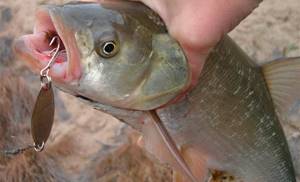
Autumn fishing differs from the rest of the hunting season in the absence of obvious fish fighting at the surface of the water, which forces the fisherman to intensively search for fish sites in depressions in reservoirs, in the so-called zones of permanent wintering pits. At this time, spinners use the heaviest baits, using bottom and pelagic jigs. Fish are the least active during this season and require the selection of a certain type of animation. Fishing is carried out throughout the daylight hours.
Catching asp with castmaster and fly
The addition of an additional type of bait to the spinner is also due to the low activity of the predator. The fly is mounted on a short and fairly rigid, up to 30 cm, lead, mounted in front of the spinner on the main cord at a distance of 20 cm. Despite the additional ties, due to the range of the spinner, the rigs fly well over long distances. When retrieving in combination, installation with additional chaotic movements of the hairy fly irritates the passive trophy, which in the end, in most cases, attacks the spinner when it stops. For the most part, this feeding option is used to catch baits in the upper layers of water.
Castmaster
Castmasters have long been asp baits, although they did not have that name. Our ancestors also successfully used nuts and pipe sections to catch the “river horse.” It is the “horse” that the asp is called for its strength and endurance in some regions.
The main advantage of castmasters is excellent aerodynamics during flight. Even a novice spinning angler can cast this bait far. Metal models fly best: pipe sections, jigs, triangular baits. And the wiring needed is quite simple. Uniform, rapid winding of the reel leads to the capture of the first asps. And then you can master the “step”, catching during the falling phase of the bait or during a pause from the bottom.
We talked about castmasters in more detail in this article.
How to fish correctly
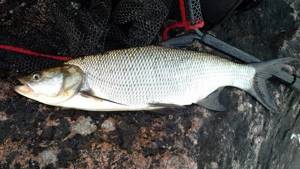
Asps, even with small sizes, show aggressive resistance to fishing, subjecting the gear to extreme loads, and the fisherman to a surge of positive emotional mood. After a powerful blow to the bait, which cannot be confused with anything else, the fish that took the spoon moves to the bottom, instantly reeling in and withdrawing the free cord. At such a moment, all responsibility falls on the clutch, the settings of which should save the form from destruction. The fish that lifts the spoon hooks itself and control hooks to fix the hook in the mouth in most cases are not required. Having taken control of the fish’s progress, they begin pumping out the trophy with the tackle, collecting the freed line with a reel. They bring the catch to the shallows or the side of the boat, where they take the asp into a landing net.
Fishing process
If the angler has followed all the rules for guiding the castmaster and the asp has responded to the bait, all that remains is to correctly remove it from the water. Haste in this matter is the main mistake of beginners. Trying to pull the trophy ashore as quickly as possible, they quickly reel in the fishing line, but this allows the fish to make a jerk and free itself.
When fishing for individuals weighing more than 5 kg, you must be extremely careful and patient. It is also important to go fishing with a good landing net with a mesh made of thick fishing line. When faced with resistance from a large asp, you need to force him to expend a lot of energy and get tired. To do this, you need to keep the line in tension and absorb sudden jerks with the help of a fishing rod or a friction brake.
